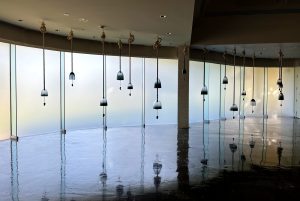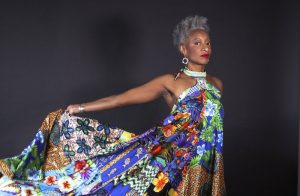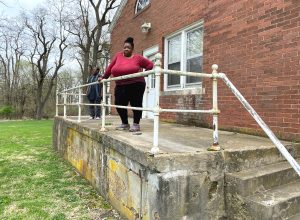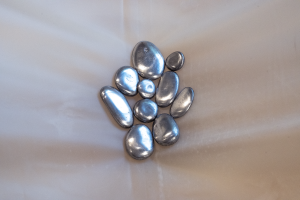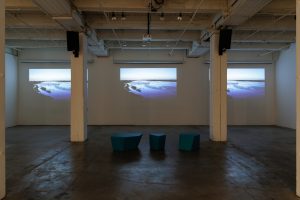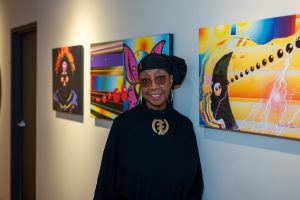Krannert Art Museum at the University of Illinois at Urbana-Champaign houses quite a large and impressive collection of artwork, spanning centuries of human creativity. The museum’s collection is complimented by temporary exhibitions, ranging in themes (Painting and the Animation of History in Northern India), time periods (contemporary work by Allan deSouza), and topics (Swalihi Arts across the Indian Ocean). It’s an understated and underappreciated resource in East Central Illinois.
I recently spoke with Amy L. Powell, Curator of Modern and Contemporary Art at Krannert Art Museum (KAM). Powell has been in her position since the fall of 2014, and she’s mounted exhibitions of the work of Zina Saro-Wiwa, Autumn Knight, Basel Abbas and Ruanne Abou-Rahme, and Kennedy Browne. Powell is interested in photography, video, and knowledge production, but a quick look at her resume also reveals thematic interests in post colonialism, feminism, displacement, and disruption.
Much of our conversation circled around the idea of connection. Powell seeks to make connections between artists, makers, and thinkers, and views the studio visit and the exhibition as platforms to pose questions and invite conversation. She is dedicated to academic museums as they are uniquely positioned to facilitate such relationships.
We spoke before COVID-19 was declared a pandemic, before our cultural institutions closed. Revisiting this interview in a time of social isolation allows for reflection on the connections and relationships we often take for granted. Making, thinking, and writing can be isolating practices. I wonder, now, how we can find ways to call upon and draw out the connections and types of relationships Powell and I discuss. What does it mean to build community in a time of social distancing?
All programs we discussed in this interview have since been indefinitely postponed. In the meantime, though, you can view KAM’s permanent collection online (including “Hive,” a large, immersive project by Nancy Davidson and Lakshmi Ramgopal) and check the website for announcements regarding rescheduled programming.
This conversation has been edited for clarity and length.
Jessica Hammie: I’m curious about how you ended up as a curator. Did you have any formative experiences in your life that led you to art?
Amy L. Powell: Oh, yes. I got to art because I grew up in a small town in central Kentucky, a town of 16,000 people, and there’s a small liberal arts college there – this is in Danville, Kentucky – and so there were more opportunities than usual, I would think. But also, I just always knew there was something more, that there was a bigger world to engage with. So [going to] college and discovering visual art was kinda my way out. But also through family: I had a gay uncle who moved to Dallas and he would host me down there. He and his partner, now his husband, supported a number of dance companies [and] a dance company in Fort Worth. And because of that connection, I was in town and they took me to a rehearsal and I remember asking “Is this their job?” “Oh yes, honey, this is their job!” [laughter] And you know, they’re dancing to Lyle Lovett, and it was just incredible. It was only a rehearsal for this dance company, but I realized that there was a world out there where creativity could drive your daily activity, and I also just loved thinking and experiencing in that space.
I grew up hiking and going to national parks, not so much going to art museums. My undergraduate degree at the University of Kentucky was in arts management, but also [I did] a double major in art history. I didn’t have models in my family for graduate school or being an art historian, but I had really great faculty there who brought in artists and curators, so I got to see that there was an art world. And then I applied to graduate schools but was always really ambivalent about being a professor, and didn’t really have models for that in my family. My first job out of school was at Blaffer Art Museum at the University of Houston, and I kinda used that to decide if I want to teach and go the academic route, or do I try this curating thing. I just loved working with artists and seeing things come to life in the space. My dissertation became a group exhibition that had a catalogue with it, and I felt that was a wonderful way to get ideas and practice out into the world.
JH: How did you arrive at the types of work that you are interested in? And how did you arrive at your research?
AP: I suppose in school I studied the history and theory of photography and the history and theory of film and video the most. And that’s just because of my persuasion – I’m just so taken with the moving image and with photography. More broadly, I’m interested in contemporary art, no matter the medium, that is based on research or takes knowledge as its form of production. So sometimes this is performance, sometimes sculpture, and right now I’m working on a drawing show. I started with my gay uncle, and I suppose I come to it from difference, knowing from a young age that different kinds of worlds exist, and it’s up to us to imagine them together – and that artists can help us do that. And a curator has a role to play in facilitating an artist’s vision, but also in framing the conversation around it.
One of the things that I love to do the most is [working with] an artist with a research-driven practice that’s related to really urgent questions – whether that’s Facebook being terrible, or the position of Black women within institutions – to connect them with scholars. I’ve been able to do that here at Krannert [Art Museum] and the University of Illinois in a way that’s just been a dream. And then those relationships take off and they’re collaborating or working with each other, that’s just terrific. So really seeing the exhibition as a starting point, instead of a culmination, for more conversation.
JH: It seems like a lot of the shows you’ve curated here at Krannert have been collaborative, and I’m curious how you think about collaboration and how that informs the projects you take on.
AP: Well, I want to make sure that what I’m interested in will have an audience, and have some purchase and relevance to teaching and research, and the things people are thinking about. I suppose I approach collaboration mostly through knowledge sharing. Because I’m interested in artists from a range of practices and backgrounds and interests, I won’t bring everything to the project, necessarily. For instance, we open[ed] Hive, this sculpture and sound installation with Nancy Davidson and Lakshmi Ramgopal, and that project developed because I solicited a proposal from Nancy for that Kincaid Pavilion space, this big glassed-in, neo-Classical, post-modern pavilion to the museum. And she proposed two hybrid goddess-maiden inflatable sculptures that reference Artemis of Ephesus, this multi-breasted cult goddess figure from the ancient world. My knowledge of the ancient world is very, very slim, so I’m glad that Clara Bosak-Schroeder [Assistant Professor of Classics, University of Illinois at Urbana-Champaign] has such a great web presence, because I’m often Googling who has what research interests and who can I talk to about a particular problem or how to frame a particular issue.
That’s one form of collaboration, but then I suppose the biggest one is co-curating. So, because the connections to the ancient world were so substantial in Nancy’s proposal, I invited Clara as a co-curator, which completely shaped the project. And Clara also knew Lakshmi, who is a Roman historian and a multidisciplinary sound artist. So Nancy wanted to collaborate with another artist on sound, and Clara knew Lakshmi and the project kinda took off from there. So these sculptures breathe. Lakshmi asked a range of people, all on the non-cis-male-gendered spectrum, to make sounds – breathing, sighing, moaning – and that all got wrapped into the space. So it’s almost like the space itself or the sculptures are making these sounds. It was just a great curatorial challenge – not only to bring together two artists who have very different practices, from different generations, from different cultural backgrounds –
JH: – And they did not know each other beforehand?
AP: – Yeah, and they did not know each other beforehand. And to have the end product be something that is actually very collaborative, and drawing on a range of knowledge and experience, is something that I could not have done alone. It wouldn’t have been as robust, and far from the same kind of project. So that’s one recent example.

JH: Just from knowing you a little bit, it seems like the studio visit is really important to you – and in the presentation of an exhibition, it seems clear that you have spent time with the artist, thinking about what it is the two of you will be presenting. I was wondering if you could speak about how you see the studio visit and what role it plays in your practice.
AP: I wish I could do more of them, because I love studio visits that don’t necessarily lead to a project – I mean they can’t all possibly, right? I think a bigger range of professional people should have studio visits, like I should have office hours or something, because it’s a time for you to really be on the spot about your ideas and articulating what is happening. It’s also a peek into process, not just on finished work, but how does this paint get mixed, how does it actually go onto the canvas. I use studio visits, especially when I’m traveling, to just meet artists – often for the first time – who I’m interested in, or I’ve seen their work somewhere, and it’s a real eye not just into process but [also] what they’re working on now.
I did a show with Kennedy Browne – Gareth Kennedy and Sarah Browne – who are these Irish artists; I did a studio visit with them in 2015 and we did a show just last year. That’s a rare case where they talked about their work so amazingly and I saw so many connections right away to research that happens here [at the University of Illinois] on critical technology studies. I kinda offered them a show on the spot. They were then making the third part of a trilogy of video and sculpture works, so they kept me posted as they were making that third part, and I would ask them questions. I don’t think I influenced the process, but I like to be an intellectual interlocutor as those things are happening.
Otherwise, the studio visit really is for me to learn, and to just be in a different kind of creative space. You know, I’m surrounded by books and I’m hunched over email a lot, so it can be a total breath of fresh air and just an utter privilege to see work in-progress. It’s really a timing issue, because so much knowledge is exchanged in that space of maybe one or two years in advance before the thing is presented, so you can become a partner or facilitator if the timing is right.

JH: How do you think about facilitating or partnering? So often I’m talking to artists, and the way they approach studio visits or their interactions with curators is often not the way you just described it. I’m curious about the other side of that. I think artists maybe see it as an opportunity: in addition to sharing their work, it’s an opportunity for someone in a position of power to offer them a chance to show their work in another platform. Do you feel that tension, or do you feel pressure about that?
AP: Sometimes, yeah. I try to dispel it. There aren’t possibly enough museum spaces to give everybody the platforms that they want. Something I learned from being in Houston, where intellectual community is really among artists, is that you have to make your own exhibition opportunities among your community. I’m definitely aware that curators play the role they do, but I think that role of support can come in many different forms – not only the ‘let’s do a solo exhibition’, but also like ‘are you reading this person?’, or I know this scholar, or this other curator and can recommend [them]. It’s really about networking, and the studio visit being part of that.
It’d be silly if I didn’t understand that there’s probably more pressure on the artist. Depending on the artist, to have someone in for feedback, much less a curator at an institution where you might like to show it, that’s a lot of pressure. I cannot possibly do all the shows that I want to do, and studio visits happen so much more frequently, and are for me just community-building. I mean, they do lead to shows, but they lead to just such a different range of projects. I have seen other curators really enjoy walking in and tossing the purse in the corner and saying, “what do you have for me today?” I suppose I’m not that way, but it’s this great weird format in that there’s no format to a studio visit, so it could go anywhere. Does the artist want feedback on a specific thing, or is it more of a dialogue about what are we reading and what do we have in common, or what are our investments, what can we work on together? Otherwise I just really enjoy them.
And at the same time, the gains are real, right? Because if the artist is on faculty at a university, or if an artist is trying to make a living from the work [then a possible exhibition or financial opportunity is of real value]. Also, curators talk among each other and if someone isn’t making a connection with one person, then they’ll refer to another or share, if the work is really solid or they’re reading about something.
JH: Yeah, exactly.
AP: No, that’s a great question. When I travel to a place, the curators at that place will want to know who I’m seeing, and they’ll judge me by who I’m seeing. [laughter] Like, “Oh, who are you visiting?”
JH: Oh, interesting.
AP: [laughter] It’s really casual; I don’t feel completely marked by that, but everybody’s just interested in who you are [seeing]. Maybe that’s key to mid-major cities or something, and not so much New York or L.A.

JH: That’s another question I have for you, is thinking about the Midwest. You do travel a lot, and I think that’s one benefit of being here in Champaign-Urbana and being affiliated with this particular university, is there’s [the] cost of living and access to airports to be able to get out. But you have spent a lot of time in the Midwest, and I’m curious about how you think of the Midwest as a unique space, and if you would consider yourself dedicated to it, since you have spent some time here? Or if that’s just coincidental?
AP: That’s a great question, yeah. I really love it here. I’ve been here for five-and-a-half years and I’ve come around to loving it here, although I’ve always loved it for the reasons you were saying: cost of living is low, and we have a house, we have a 3-year-old, it’s a 10-minute commute to anywhere. And the intellectual community here is kinda unmatched. My artist friends in New York don’t have collaborations or friendships outside the ones they already brought to the city; it’s kinda impossible to see and cultivate new things beyond the community you already bring. And I feel like I’m still meeting new people and just really enjoying it [here].
I’m really interested in institutional history and institutional transformation; I really value conversations with other people who bring different perspectives. I’m just really interested in how to move within and against, and the University of Illinois has been great for that – I mean, I suppose we all answer to the Board of Trustees at the University of Illinois – [but] the museum itself doesn’t have a board. By already integrating research questions we can be a little more free from the pressures of the art market or galleries to show certain artists because those galleries are gonna fund particular exhibitions. We’re really successful here with grants, and hopefully more so with individual corporate fundraising, things like that. So I feel a little more intellectual freedom than my colleagues who are at big civic museums; I’ve never worked at a big civic museum so I couldn’t really say.
I’m committed to, I think, this type of institution. I went to school at the University of Wisconsin Madison, and have family outside of Madison and sort of grew up going there, too. So I’ve never thought about whether I’m committed to the Midwest. I have family in New York and would go in a heartbeat, and I would go back to Houston in a heartbeat, given the right opportunity. I really miss seeing a lot of work all the time, and independent cinema, and just all the things you have in a city. But I understand, especially right now, that that comes at a cost, and we have a lot of richness here in terms of cost of living – and there’s a lot going on, and we’re close to Chicago, and there’s a lot going on here.
I think I’m committed to knowledge institutions. The Research I institutions here are just really strong, and so for university museums this is really it. And then, when we bring artists here they love it, they love meeting all the faculty, and being here and having access to archives, and any number of things. So I’m committed to Champaign-Urbana for now, I’d say. And really, I learn a lot and really value people who have been here longer, whether it’s an artist or another contemporary [organization], thriving here in East Central Illinois. I think a lot about local audiences, but also how we’re participating in the national and international contemporary art scene.
JH: What’s your relationship with local artists and the local art scene here in Champaign-Urbana, and even regionally?
AP: I wish I could make time to do more studio visits. I have good relationships with art faculty here [at the University] and I wish I could be in their studios more. And then there are artists who are maybe retired from teaching here, who I know and have worked with – we have a Bea Nettles exhibition coming up in the fall that’s organized by two other institutions, but I had started working on it on my own. I suppose my connections with local artists are really through the University.
JH: You brought up Bea Nettles, and something that I’ve noticed about the shows that you’ve curated particularly here at Krannert, is that it seems like you’re dedicated to showing women, so I was wondering if you could talk a little bit about that? Because that feels intentional.
AP: I need to think more about that, because it goes back to the community question. I show people who I have affinities with and knowledge and investments in what we want to see happen – in terms of the transformation of space, in terms of what an artwork can do in the world. And it happens to be women, and happens to be a lot of collaborations. I’ve worked with Raqs Media Collective; I’ve worked with Antena, which [at the time was] a collaboration of John Pluecker and Jen Hofer. And now this collaborative project for Hive. These just wind up being the people I want to think with. I’m not categorically saying I wouldn’t do shows with certain [people] –
JH: – No, of course not.
AP: Yeah, but it’s definitely intentional [who I work with]. And also, when we project out to future semesters and we see what shows line up with other shows, we think about how those dialogue with each other, especially alongside collections installations.
I haven’t been to the new MoMA, but some of the better critiques of it – like Helen Molesworth in Art Forum or Aruna D’Souza in 4Columns – have talked about how this is an additive approach to art history: the structure is still intact. And my education is that the structure cannot possibly be intact. So when I’m thinking about how to include work by contemporary Indigenous artists in our collections installations, I want them to be centered and not sequestered, not all on their own or additive to this other history. And that’s where I think the project of institutional transformation can happen, and once you center [something like] a Nick Cave sound suit, then all sorts of other questions start to come, and not just certain genealogies or lineages.
Here at Krannert Art Museum we have a really strong post-war abstract painting collection because that’s what the University collected from the late ‘40s forward. But there’s also lots of weird regional realist stuff, so we’re maybe more privileged than MoMA in that we don’t have to go through Picasso, we don’t have to go through these certain figures. But still, the work I’m interested in tends to really unsettle a lot of established categories, and often that tends to be women, because that’s where their investments are.

JH: Thinking about disruption as a theme, I’m wondering how you navigate these spaces as a woman – which I think is inherently disruptive in many ways – and also as a white person?
AP: Maybe that’s where collaboration comes in. I don’t ever claim to speak for positions that aren’t mine, and whenever I’m describing artwork, or something that an artist or artwork is doing, it’s not about me. I really feel like I’m a medium for things to come through, you know. Yeah, that’s a complicated question.
JH: It is a complicated question. Sorry!
AP: Yeah, it’s a great question. And you ask it because of the type of work I’m committed to?
JH: The type of work that you’re committed to, sure, in part. But also that these are the conversations that are being had outside and within the art world, and you can’t escape the daily news without hearing about wrongdoings perpetrated by cis hetero white men, or, thinking about supporting marginalized communities, and allyship, and being disruptors.
AP: I’m also definitely still learning lessons about when I am a facilitator and when I am the one doing the thing, how much space I take up and how much space I facilitate and stand back for. And I would be learning that anyway through collaboration. But because of the different material that we’re working with, it definitely comes up as sensitive. I mean, I think the result of these renewed culture wars won’t be that people only stay in their lanes of representation. I don’t think that those lanes exist – that Black curators only show Black artists or show artists only from a certain kind of experience. Those cross-conversations and conversations in solidarity with one another can often be just really rich.
It’s also just me as a person. I want to kind of erase myself and my role – maybe that’s why I’m a curator is that I like to be behind the scenes. I really value my voice in the publications that we do, and the kind of framing – whether it’s the wall text in an exhibition or the essay – that’s where I feel like I need to stand strong and have the clear opinion. Otherwise, I try to just facilitate. I’m always thinking about subjectivity and positions, and differences in power.
JH: My opinion is that it’s just better thinking and better curating, but also our question asking and problem-solving – or problem-making, in some ways.
AP: Yeah, where does it take us, what does it generate, what is it we’re working on together.

JH: You mentioned curating Indigenous artists’ work in the collection, and I know that this calendar year KAM is doing a Native American artists series. Can you tell me a little bit about how that came to fruition? Basically, why KAM and why now?
AP: The museum is arguably the most important place where audiences can come together to discuss, and also to see work that doesn’t just tackle issues of Native stereotypes but is some of the best work being made now.
When KAM’s director Jon Seydl [was hired] almost two years ago now, he made Native American issues a real priority. So the answer to the question about doing a series of Native American visiting artists was really John’s idea, and through his collaboration and our collaboration with Native American House. Nichole Boyd, the director there, is really interested in artists and a lot stuff happening around Native artists. We also are hosting this exhibition Hot Spots: Radioactivity and the Landscape, and there are two Native artists there – and issues of nuclear exposure affect Native lands so much more, so [we were able] to use that exhibition as a platform. The curator Candice Hopkins, [exhibiting artist] Naomi Bebo, and [artist]Andrea Carlson [were] in conversation with each other a couple times.And the painter Duane Slick is coming at the end of March, and then Raven Chacon, formerly of Postcommodity, but [who is] now a musician. There are curators trained in contemporary Native art, and I am not one of those curators, but I’ve really enjoyed learning about exhibitions and artists and who can we bring into the collection or to consult with us, and how do we build the collections and our exhibition programs so that we’re centering issues of indigeneity – which absolutely involves our own history at University of Illinois, but it can be more oblique and stealthy. But it’s definitely one of the biggest questions for us.
Museums as an idea have traditionally not been open to everyone, they’ve only presented certain kinds of histories. So I want to make sure that our projects and programs are welcoming to everyone, especially people who don’t think that their stories are being told in museums. I’m just convinced that’s where the work needs to be.
Featured Image: Amy L. Powell, Curator of Modern and Contemporary Art at Krannert Art Museum stands in front of “Hive,” an large inflatable sculpture installed in the museum’s Kinkaid Pavillion. The sculpture is floor to ceiling and bright pink. The main body of the sculpture resembles a bunch of grapes, or a multi-breasted female body, and to the side there is fuschia colored a braid with a braided gold band around the end of the braid. Powell stands in the center of the image, looking into the camera and smiling. She is wearing a black dress, and her hands are in her pockets. Photo by Jessica Hammie.


Jessica Hammie is a writer based in Champaign, Illinois. She earned an MA in Art History from the University of Connecticut, where she studied hip-hop’s influence on contemporary art practices. Jessica writes about how artists visualize identities, and how arts help us understand our interconnected public and private histories. In addition to writing for Sixty, she is Managing Editor at Smile Politely, a Champaign-based culture magazine.

